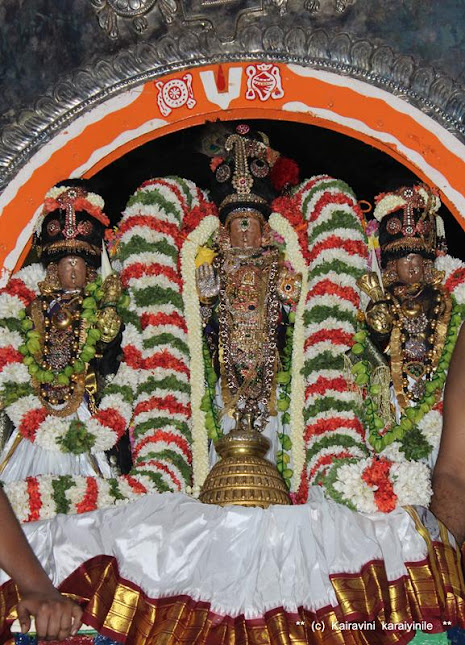திருவல்லிக்கேணி பிரம்மோத்சவத்தில் நான்காம் நாள் காலை சூர்யப்பிரபை.
மாலை சந்திரப்ரபை வாகனங்கள். சந்திரன் குளிர்ச்சியானவன்; சந்திரனுக்கு அம்புலி, வெண்மதி, பிறை,
கலாநிதி, நிசாகரன், மதி, சுதாகரன், என பெயர்கள்
உண்டு. முழுமதி மிகவும் சந்தோஷத்தை தர வல்லது. நிலவை நோக்கி கைநீட்டி,
தன் குழந்தையுடன் விளையாட வருமாறு அம்புலியை அழைக்கும் பருவம் - அம்புலிப்பருவம்.
Luna 1 was launched at 16:41
GMT on 2 January 1959 from Site 1/5 at the Baikonur Cosmodrome by a Luna 8K72
rocket. Luna 1 missed its target by
5,995 kilometers (3,725 mi). The
spacecraft passed within 5,995–6,400 kilometers (3,725–3,977 mi) of the Moon's
surface on 4 January after 34 hours of flight, and became the first man made
object to leave earth's orbit. Luna 1 ran out of battery power on 5 January
1959 when it was 597,000 kilometers (371,000 mi) from Earth, making it
impossible to track further. It
perhaps still remains in orbit around
the Sun, between the orbits of Earth and Mars.
Chandiran, Nilavu, Ambuli, Moon has
enamoured mankind for ages - A miniature rover being developed to explore the
Moon's surface is on track to join the search for water there, its Hungarian
inventors believe - using a device that weighs less than a bag of sugar. Named
after a Hungarian breed of dog, the Puli rover is a low-cost platform designed
to carry different payloads, including the ice water snooper, which won the
2020 "Honey, I Shrunk the NASA Payload" challenge, a competition
organised by the U.S. space agency.
The Moon (or Luna) is the
Earth’s only natural satellite – considered to have been formed 4.6 billion years ago around some
30–50 million years after the formation of the solar system. The Moon is in
synchronous rotation with Earth meaning the same side is always facing the
Earth. In reality both sides of the Moon
see the same amount of sunlight however only one face of the Moon is ever seen
from Earth. This is because the Moon rotates around on its own axis in exactly
the same time it takes to orbit the Earth, meaning the same side is always
facing the Earth.
Luna 1, also known as Mechta
(meaning dream in Russian), was the first spacecraft to reach the vicinity of
Earth's Moon, and the first spacecraft to be placed in heliocentric orbit.
Intended as an impactor, Luna 1 was launched as part of the Soviet Luna
programme in 1959. A malfunction in the ground-based control system caused an
error in the upper stage rocket's burn time, and the spacecraft missed the Moon
by 5900 km (more than three times the Moon's radius). Luna 1 became the first
human-made object to reach heliocentric orbit and was dubbed "Artificial
Planet 1" – and was also referred to as the "First Cosmic Ship”.
Between 1968 and 1972,
crewed missions to the Moon were conducted by the United States as part of the
Apollo program. Apollo 8 was the first crewed mission to enter orbit in
December 1968, and it was followed by Apollo 10 in May 1969. Six missions
landed men on the Moon, beginning with Apollo 11 in July 1969, during which
Neil Armstrong became the first man to walk on the Moon. Apollo 13 was intended
to land; however, it was restricted to a flyby due to a malfunction aboard the
spacecraft. All nine crewed missions returned safely to the Earth.
While the United States
focused on the crewed Apollo program, the Soviet Union conducted uncrewed
missions that deployed rovers and returned samples to the Earth. Three rover
missions were launched, of which two were successful, and eleven sample return
flights were attempted with three successes. Moon has enamoured mankind
for ages – in our literature and in Divyaprabhandnam too, there is mention of
moon in many a places. Moon is
characterised as a cool, pleasant one. At Thiruvallikkeni there is Chandra prabhai
purappadu on Ratha Sapthami day – and on
day 4 evening of Brahmothsavams.
Here are some photos of Sri Azhagiya Singar Chandra prabhai purappadu
this evening.
Mamandur Veeravalli Srinivasan Sampathkumar
5.3.2021
















No comments:
Post a Comment